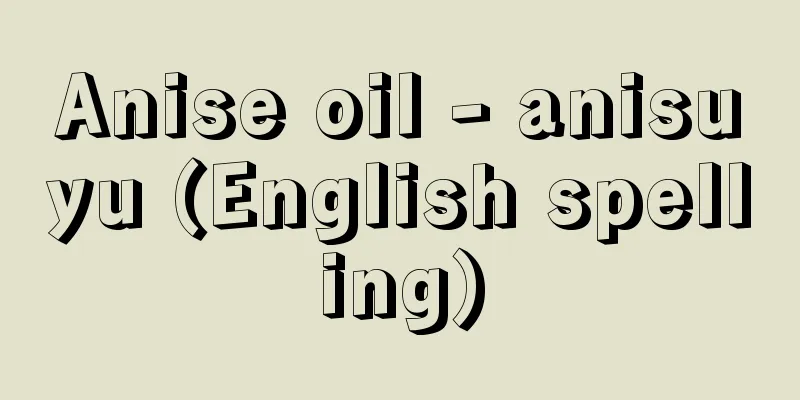Sorcery - Jujutsu

|
An act aimed at achieving desirable things such as healing from illness, rain, good harvests, and abundant catches by appealing to supernatural beings. [Teigo Yoshida] The meaning and types of sorcerySorcery is a translation of the English word "magic" and can also be called "charm" or "magic," but since magicians are also called "magicians," the word "sorcery" is used to distinguish it from magic. Etymologically, magic comes from the ancient Persian word "Magus" (a group whose profession is divination and sorcery), and the Greek word "magos" (Magus people, sorcerers) is a loanword from that. Behind this act there is often a belief in supernatural beings, but this belief is not necessarily a prerequisite for sorcerous acts. J. Frazer made a clear distinction between magic and religion, stating that magic is an attempt to achieve a goal by controlling supernatural spirits, while religion is a petition to spirits. However, the distinction between the two is not clear in many religious systems of various ethnic groups, and the term religion is often used to include magic, and the terms "magic and religious" are also used. Frazer also viewed the relationship between magic and religion as a stage of development, arguing that magic is more primitive than religion, but even among hunter-gatherers, who are considered to be the most primitive, religious systems centered around the worship of a supreme god are often found, so magic cannot be said to be necessarily old. For example, when comparing the San, a hunter-gatherer people of Africa, and the Minangkabau, an agricultural people living in Sumatra, Indonesia, the latter is culturally more complex, but magic is more prominent among the Minangkabau. In traditional societies around the world, rain-making rituals are held in which water is sprinkled and drums are beaten after a long period of drought. The magic of sprinkling water on the ground and beating drums imitates rain and thunder. Frazer called this kind of magic, which mimics desirable phenomena, "analogous magic" or "imitation magic." In contrast, in Japan, there is a custom of collecting rags of cloth from healthy children and sewing them together to dress sick children in order to make them healthy. This is what Frazer called "contagious magic," and is also known as "contact magic." Another type of contagious magic is the magic of burning a person's hair, nails, excrement, or clothing in order to make others sick. Magic for praying for rain or restoring health is also called "white magic," as it is magic performed for the benefit of society and people. Sorcery used to torment, curse, or kill people is called "black sorcery" or "sorcery." [Teigo Yoshida] Magic and the worldMagic is closely related to the worldview of a society. For example, in Bali, Indonesia, like other Indonesian regions, there is a belief that the right hand is superior and the left hand is impure. However, here, magic is divided into "right magic" and "left magic." "Right magic" is "white magic" for good purposes, such as magic to cure illness, while "left magic" is "black magic," a bad magic to curse and kill people. In Bali, one way to cure illnesses caused by magic is to take young fruits from the northeast side of a coconut tree, fry a type of land snail called cekuri and a sea snail called runsil in oil, put the oil into the coconut, mix it, and have the patient drink it. The reason why coconuts from the northeast side are used is because the northeast is considered to be a good direction in southern Bali. In Bali, the symbolic dualism of "towards the mountains" and "towards the sea" is prominent, with "towards the mountains" being considered a sacred direction and "towards the sea" being considered an impure direction. As central Bali is mountainous, "towards the mountains" is roughly north in southern Bali, while in the north it is south. At the same time, the east is considered sacred, so the northeast is the best direction in southern Bali. The fact that palm kernels that end up on the northeast side are revered as medicines stems from this Balinese view of direction. The Tzotzil-speaking Indians of southern Mexico, a Mayan language group, perform magical and religious ceremonies to treat illnesses. These are performed by medicine men, and the ceremonies for treating illnesses are generally performed facing east. It is said that if a chicken is killed during the ceremony by twisting its neck and falls with its head facing east, the patient will recover completely. Also, when several candles are placed around the patient during the ceremony and burn out, if the wick falls toward the east, it means the patient will recover. This is thought to be because they respect the east as "where the sun rises" and consider the west as "where the sun sets" and is an evil direction. These Indians classify food, drink, and plants into the categories of "hot" and "cold." When performing sorcery, if one buries beef, which is classified as "hot," in a cave, the victim will suffer from fever and diarrhea, and if one buries foods that are also considered "hot," such as eggs, snails, or fish, the victim's stomach will become hot. It is believed that if one buries pork, which is classified as "cold," the victim will feel chills and catch a cold. It is said that burying a pig's head facing west will cool the victim's stomach and cause diarrhea. This also reflects the idea that the "place where the sun sets" (the west) is an evil direction. A healthy body is one in which the balance between "hot" and "cold" is maintained, and if this balance is disrupted and the body becomes too "hot" or too "cold," the victim will become ill. It is the role of the sorcerer to restore this balance through magical and religious rituals. [Teigo Yoshida] Witchcraft and sorceryIn Europe, so-called "witch hunts" were widely practiced from the 16th to the 17th century. A witch is a woman who is believed to harm others in some supernatural way. It is clear that most of those who were believed to have made others sick or harmed others through witchcraft were women, but there were also men, so the word "witch" is not necessarily appropriate. The belief that witchcraft can make others sick or harm others is not limited to Europe, but is seen in many traditional societies, including the aforementioned Indians, and in many societies, those accused of using witchcraft (evil magic) are women, but there are also some societies, such as the Lugbara in Africa, where it is always men. Therefore, the word "witch" is not appropriate for making a broad comparison of such phenomena. In cultural anthropology, the words "sorcerer" and "evil sorcerer" are often used, and sometimes the English word "witch" is used as it is, without any need to use the Japanese word. The Azande people of Africa believe that if a person has a mysterious spiritual power that causes them to hate or envy others, they can bring misfortune to that person, even if they do not intend to do so. Such a type of spiritual action can be called witchcraft. There is also the idea of sorcery (evil magic) which is done intentionally to bring misfortune to others. The Azande make this distinction between witchcraft and evil magic, but in many traditional societies the distinction between the two is not clearly made, and there are often societies where the belief in evil magic as spoken of by the Azande people is present and the idea of witchcraft, which means unintentional spiritual action, is lacking. What must be noted here is the difference between the European idea of witchcraft and that of the Azande. In the former case, Christian theology and scientific thought existed, and witchcraft cannot be discussed apart from the context of the idea systems of both cultures. Accusations of suspected witches, sorcerers, and sorcerers occur to a greater or lesser extent in every society, but nowhere was such accusation and persecution as intense as it was in 16th and 17th century Europe. In European beliefs in witchcraft, the distinction between sorcery and witchcraft is not always clear, and it is not possible to include all of this in the category of sorcery as deliberate sorcery. It is also clear that the idea of witchcraft in Europe was not created by Christianity, but existed before the spread of Christianity. Christianized Western society characterized it as a certain stereotype, and violently persecuted witches, believing that they had made a pact with the devil. The heyday of European witchcraft (16th-17th centuries) was a time when a storm of economic, political, and social change was raging throughout the country, and such social unrest is said to have been one of the factors that intensified the persecution of those who were considered witches. In societies where belief in witchcraft and sorcery exists, measures are naturally taken to counteract, prevent, and cure these. In some cases, discovery of the person who cast the witchcraft (or sorcery) is a prerequisite for treatment. To prevent witchcraft, "upside-down magic" is used, such as putting underwear over the head, or the magic of excrement is utilized. When treating patients with witchcraft, a type of magic called symbolic reversal is sometimes performed. Among the Mayan Indians of Mexico, witch doctors perform rituals to treat illnesses, and one witch doctor says that when treating illnesses caused by witchcraft, they turn a candle upside down, cut off the bottom to expose the wick, light it, and pray. This is said to be to "reverse" the witchcraft, and the idea of symbolic reversal can be seen here. In many societies (for example, the Bakweli society), witchcraft is linked to the idea of "jealousy" and "envy," and it is believed that if one incurs the jealousy of a witchdoctor, one will become his prey. It is said that among the African farming people, the Nyakyusa, witches fly through the air at night and attack those who bear grudges. It is believed that being the target of jealousy makes one more vulnerable to witchcraft attacks. Witches are also said to target stingy people. In other words, it is believed that witches attack stingy people, unkind people, and people who are too successful. Such people are also more likely to be suspected by witchcraft. Thus, it cannot be denied that the fear of witchcraft and evil arts has the aspect of forcing people to conform to social norms. [Teigo Yoshida] Image of witchcraftSome scholars say that the concept of witchcraft differs significantly from one society to another, and that the term witchcraft should not be used lightly. On the other hand, there are similarities in the concept of witchcraft among different peoples who are geographically, historically, and culturally distant from each other. In many African societies, ancient Rome, medieval and early modern Europe, and the Navajo of North America, witches are believed to be able to transform themselves into animals and eat human corpses. In Kedang, Longreng (Lembata) Island in eastern Indonesia, witches are also believed to transform into crows, rats, and snakes. The image of witchcraft in various societies is the opposite of the society's righteousness, goodness, and normal people, and is an image of evil. The basic conditions for social order are not that different from one society to another, so there are similar elements in the image of witchcraft, despite the differences. In the Lugbara societies of Africa, the witchdoctor (always male) is believed to be able to transform into an animal, has white or grey skin instead of black, and has some physical anomaly: he may be lame, hunched, have one testicle, be sexually impotent, commit incest, eat human flesh, or walk on his hands at night - all of these are either the opposite of, or different from, the normal human. According to the image of a witch doctor among the Dinka, a cattle-herding people living in the Nile basin who have a different language and culture from the Lugbara, the witch doctor has a short tail the size of a human finger. The Dinka never defecate in the middle of their homesteads, but always go to wild areas to defecate. However, witch doctors defecate in the middle of their homesteads or secretly urinate in cooking vessels before running away. The Mandari ethnic group in South Sudan also believe that witch doctors have tails, eat human corpses, and commit bestiality. They also defecate in places where they should not. All of these are things that normal people do not do, and are inverted elements of normal behavior. Norman Corn argues that the collective black masses that European witches supposedly performed did not actually take place, but represent one of these images of witches. [Teigo Yoshida] Modern society and magicIn modern society, magical practices have not disappeared. You can often see beckoning cats placed in restaurants and omamori (charms) from shrines and temples on cars. Beckoning cats and omamori (charms) are talismans. It is also common to choose an auspicious day for a wedding. With the advancement of science and technology, the view that the magic and popular beliefs that have been passed down since ancient times are irrational has emerged and these have come to be called "superstitions." The concept of "superstition" itself is something that is born with the modernization of society, and the beliefs of others that one does not believe in are often called superstitions. In his book "Primitive Cultures" (1871), EB Tylor once described magic as an "illusion" that has plagued humanity, but as field surveys have progressed, it has become clear that for many residents, it is an undeniable "reality." Furthermore, some now believe that the words "magic" and "witchcraft" themselves are based on a condescending way of thinking from a Western rationalist perspective and ignore the "logic" of non-Western societies. Also, from the 1970s and 1980s, there were discussions that the witchcraft and shamanism of the Native Americans contained phenomena that could not be explained by Western science, and an anthropologist (Fabre Saada) who investigated witchcraft in rural areas in France stated in a book in 1977 that witchcraft has an objective reality. Anthropologists (Stohler and Orkes) who conducted research in Songhai, Africa, wrote about their experiences of being attacked by witchcraft. [Teigo Yoshida] "Sorceress" by J.A. Roney, translated by Yoshida Teigo (1984, Hakusuisha, Que sais-je Bunko)" ▽ "The Illustrated Encyclopedia of Japanese Sorcery" by Toyoshima Yasukuni (1998, Hara Shobo)" ▽ "The World of the Azande People: Witchcraft, Oracles and Spells" by E.E. Evans-Pritchard, translated by Mukai Motoko (2001, Misuzu Shobo)" ▽ "An Easy-to-Understand History of Japanese Sorcery: How Sorcery Driven Japanese Politics and Society" edited by Takemitsu Makoto (2001, Tokyo Bijutsu)" ▽ "Sorceress in China" by Matsumoto Koichi (2001, Taishukan Shoten) " ▽ "Japan: A Country Created by Sorcery" by Ueda Atsushi (2002, Kobunsha)" ▽ "The Book of Secret Magic Techniques - A Practical Guide to Shinto and Buddhist Magic Techniques" and "The Book of Secret Magic Techniques - A Practical Guide to Shinto and Buddhist Magic Techniques 2" (2000, 2003, Hara Shobo) written by Shinichiro Kurozuka and supervised by Yasukuni Toyoshima. "Magic" by Teigo Yoshida (Kodansha Gendai Shinsho) [References] | | | | | | | |Source: Shogakukan Encyclopedia Nipponica About Encyclopedia Nipponica Information | Legend |
|
超自然的な存在に訴えることによって、病気治療、降雨、豊作、豊漁などの望ましいことの実現を目ざした行為。 [吉田禎吾] 呪術の意味と種類呪術は英語のmagicの訳で、まじない、魔術ともいわれるが、手品師を魔術師ともいうので、手品と区別するために呪術という語が用いられている。magicは、語源的には古代ペルシア語のMagus(占いや呪術を職業としている集団)に由来し、ギリシア語のmagos(マグス人、呪術師)はその借用語である。この行為の背後には超自然的存在に関する信仰が存在することが多いが、信仰が呪術的行為の前提であるとは限らない。 J・フレーザーは、呪術が超自然的霊格を統御することによって目的を達成しようとするのに対して、宗教は霊格に対する懇願であると述べて、両者を峻別(しゅんべつ)した。しかし、諸民族の宗教体系には両者の区別が明瞭(めいりょう)でないものが多く、宗教という用語のなかに呪術を含んで使われることが少なくないし、「呪術・宗教的」という語も用いられる。フレーザーはまた呪術と宗教の関係を発達段階としてとらえ、呪術のほうが宗教よりもより原始的であると論じたが、もっとも原始的とされる狩猟採集民においても、至高神の崇拝をめぐる宗教体系がみられることがしばしばあり、一概に呪術が古いとはいえない。たとえばアフリカの狩猟民であるサンとインドネシアのスマトラに住む農耕民ミナンカバウとを比較した場合、文化的には後者のほうが複雑であるが、呪術はミナンカバウのほうにいっそう顕著である。 長い間日照りが続くと、水をまいたり、太鼓をたたいたりして行う雨乞(あまご)い儀礼は世界各地の伝統社会にみられるが、水を地面にまき、太鼓をたたいたりする呪術は、降雨と雷鳴のまねである。このように望ましい現象と似たことを行う呪術を、フレーザーは「類感呪術」あるいは「模倣呪術」とよんだ。これに対し、日本に、病弱な子供を健康にするために、じょうぶな子供の着ていた着物の布きれを集め、それを縫い合わせて着せるという習慣がある。これは、フレーザーが「感染呪術」とよんだもので、「接触呪術」ともいわれる。他人を病気にさせるために、その人の毛髪、爪(つめ)、排泄(はいせつ)物、衣服などを火にかけたりする呪術も、感染呪術の一種である。雨乞いとか健康回復を目ざす呪術は、社会や人のために行う呪術として「白い呪術」ともいわれる。人を苦しめ呪(のろ)い殺すための呪術は「黒い呪術」といい、「邪術」sorceryともいわれる。 [吉田禎吾] 呪術と世界観呪術はその社会の世界観と密接に関係している。たとえばインドネシアのバリ島には、他のインドネシア諸地域におけるように、右(手)を優越したものとして尊び、左(手)を不浄視する思想があるが、ここでは、呪術を「右の呪術」と「左の呪術」とに分け、「右の呪術」が病気の治療などを図る呪術のように、よい目的のための「白い呪術」であるのに対し、「左の呪術」は人を呪い殺すための悪い呪術、邪術、「黒い呪術」である。バリ島では、邪術によってかけられた病気を治す方法の一つとして、ヤシの木の北東側になっている若い実をとり、チュクリという陸貝の一種と、海のルンシルと称する貝を油で揚げ、その油をヤシの実の中に入れて混ぜたものを患者に飲ませるという。なぜ北東側になっているヤシの実を使うかというと、バリ南部では北東側がよい方角と考えられているからである。バリでは、「山の方」と「海の方」という象徴的二元論が際だっており、「山の方」が神聖な方角であり、「海の方」が不浄な方角とされている。バリ島中部が山岳地帯になっているため、バリ南部では「山の方」がほぼ北方にあたり、北部では「山の方」が南方にあたる。これとともに、東方を神聖視するので、バリ南部では北東がもっともよい方角となる。北東側になったヤシの実が治療薬として尊重されるのは、このようなバリの方位観に由来している。 メキシコ南部のマヤ語族に属するツォツィルTzotzil語を話すインディオは、病気を治療するための呪術・宗教的な儀礼を行っている。これを行うのは呪医で、病気治療のための儀礼は一般に東に向かって行う。儀礼のなかで首をひねって殺した鶏が、頭を東に向けて倒れると病気は全快するといわれる。また儀礼のなかで患者の周りに立てた何本ものろうそくが燃え尽きたとき、芯(しん)が東の方に倒れるのは病気の回復を意味するという。これは、彼らが東を「日が昇る所」として尊重し、西を「日の沈む所」として悪い方位としているところからきていると思われる。 これらのインディオは、飲食物や植物を「熱い」と「冷たい」のカテゴリーに分類しているが、邪術を行う場合、洞窟(どうくつ)の中で「熱い」と分類されている牛肉を埋めると、相手は発熱と下痢に苦しむとされ、卵、カタツムリ、魚など同様に「熱い」とされている食物を埋めると、相手の胃が熱くなるという。そして「冷たい」と分類される豚肉を埋めると、相手は寒気を催し、風邪(かぜ)をひくと考えられている。豚の頭を西向きに埋めると、相手の腹を冷やし、下痢をおこすという。ここに「日の沈む所」(西)を悪い方位とする観念も表れている。健康体は「熱い」と「冷たい」の均衡が保たれていることであり、この均衡が崩れ、「熱い」状態になりすぎると、また「冷たい」状態になりすぎると病気になるとされている。これを呪術・宗教的な儀礼によってもとの均衡状態に戻すのが呪医の役割なのである。 [吉田禎吾] 妖術と邪術ヨーロッパにおいて16世紀から17世紀にかけて、いわゆる「魔女狩り」が盛んに行われた。魔女というのは、なにか超自然的な方法で他人に害を与えるとされる女性のことである。呪術によって他人を病気にさせ、あるいは危害を与えるとされた者の多くが女性であったことは明らかであるが、なかには男性もいたので、魔女という語はかならずしも適切でない。呪術によって他人を病気にさせたり、危害を与えることができるという信仰はヨーロッパに限らず、前述のインディオそのほか多くの伝統社会にみられ、呪術(邪術)を用いたと非難される者が女性である社会も少なくないが、なかには、アフリカのルグバラLugbaraのようにつねに男性である社会もある。したがって、こういう現象を広く比較してみるためには、魔女という語は適切でない。文化人類学では妖術(ようじゅつ)師とか邪術師という語のほうが用いられることが多いし、しいて日本語にせず、英語のウィッチwitchという語がそのまま使われることもある。 アフリカのアザンデの人々の間では、ある人のもっている神秘的な霊力が働き、その人に意図がなくても、他人に憎しみやねたみを感ずると、相手の人に災いをもたらすと信じられている。そのような一種の心霊作用は妖術witchcraftといえよう。このほかに意図的に他人に災いを与えるために行う呪術(邪術)の観念がある。このように妖術と邪術の区別はアザンデの人々が行っているのであって、伝統社会において、両者の区別が明白になされていない所も多く、アザンデの人々のいうような邪術の信仰があって、無意図的な心霊作用を意味する妖術の観念の欠如している社会もしばしばある。ここで注意しなければならないのは、ヨーロッパの妖術の観念と、アザンデのそれとの相違である。前者の場合にはキリスト教神学とともに科学思想が存在していたわけで、両文化の観念体系という脈絡を離れて妖術を論ずることはできない。 魔女、妖術師、邪術師などの容疑者に対する非難はどの社会においても大なり小なり行われるが、こういう非難や迫害が16、17世紀のヨーロッパにおけるほど激しく行われた例はほかに見当たらない。 ヨーロッパの妖術信仰においては、前述の邪術と妖術の区別はかならずしも明白ではなく、これをすべて意図的な呪術としての邪術に含めてしまうことはできない。またヨーロッパにおける妖術観念はキリスト教が生み出したものではなく、キリスト教が広がる前から存在したことも明らかである。キリスト教化された西洋社会がそれを一定のステレオタイプに性格づけ、妖術師を悪魔と契約を結んだものとして激しく迫害したのである。ヨーロッパの妖術の全盛期(16~17世紀)は、経済的、政治的、社会的な変動の嵐(あらし)が各地に巻き起こっていた時代であり、このような社会不安は妖術師とされた者への迫害を激化させた一因であるといわれる。 妖術や邪術の信仰が存在する社会では、当然これらに対抗するための手段、これらを防ぎ、治療する手段がとられる。治療の場合に、妖術(邪術)をかけた者の発見が必要条件とされることもある。予防のためには、下につける下着を頭にかぶるような「逆さまの呪力」を用いるとか、排泄物の呪力を活用することがある。 妖術(邪術)の患者を治療する場合にも、象徴的逆転といわれる呪術が行われることがある。メキシコのマヤ系インディオにおいては、呪医が病気治療のための儀礼を行うが、邪術による病気の治療においては、ある呪医によると、ろうそくを逆さまにし、その底部を切ってしんを出し、これに火をともして祈る。これは邪術を「ひっくり返すため」であるといわれ、ここに象徴的逆転の観念がうかがえる。 妖術はいろいろな社会で(たとえばバクウェリの社会で)「ねたみ」「そねみ」の観念と結び付いており、妖術師のねたみを買うとその餌食(えじき)になると信じられている。アフリカの農耕民ニャキュサの妖術師は、夜間に空中を飛んできて、恨みに思う者を襲うとされている。ねたみを受けると妖術師の攻撃を受けやすいとされている。また妖術師は、けちな人をねらうともいわれる。要するに妖術師は、けちな人間や、不親切な人間、成功しすぎた人間を襲うと信じられている。こういう人間はまた妖術師の嫌疑を受けやすい。このように、妖術や邪術に対する恐怖が、人々に社会の規範に従わせるという面を備えていることは否定できない。 [吉田禎吾] 妖術のイメージ妖術の観念が存在する多くの社会において、妖術の観念はそれぞれの社会に応じて著しく異なり、妖術という語を安易に使うべきでないとする学者もいる。しかし反面において、互いに地理的、歴史的、文化的にかけ離れ、異なる諸民族の間に存在している妖術師の観念には類似点もみられる。多くのアフリカ社会、古代ローマ、中世から近世にかけてのヨーロッパ、北アメリカのナバホには、妖術師自ら動物に変身することができ、人の死体を食べると考えられている。東インドネシアのロングレン(レンバタ)島のケダンでも、妖術師はカラス、ネズミ、蛇に変身するとされている。いろんな社会における妖術師のイメージは、その社会の正しさ、善、常人とまったく反対のイメージであり、邪悪のイメージである。社会の秩序に関する基本的な条件はどの社会においてもそれほど違うものではないので、妖術者についてのイメージには、差異のある反面、このように類似する要素がみられるのである。アフリカのルグバラの社会では、妖術師(つねに男性である)は動物に変身できると信じられており、普通の人間が黒いのに対して妖術師の皮膚の色は白いか灰色であり、身体のどこかにほかとは異なる点があるとされている。足が不自由であったり、背が曲がっていたり、睾丸(こうがん)が一つであるとか、性的に不能であるとか、あるいは近親相姦(そうかん)を行い、人肉を食べるといわれ、さらに夜に逆立ちして歩くという。これらはいずれも普通の人間の正反対の特徴か、どこか普通の人と違う点を備えている。 ルグバラとは言語と文化の異なるナイル川流域の牧牛民ディンカDinkaの妖術師のイメージをみると、妖術師には人間の指くらいの短いしっぽがついているという。ディンカはホームステッド(居留している土地)の真ん中で排便することはなく、つねに野生の土地に行ってする。ところが、妖術師はホームステッドの真ん中で排便したり、料理用の器にひそかに小便をして逃げるという。南スーダンの民族集団マンダリMandariにおいても、妖術師にはしっぽがあるとか、妖術師は人間の死体を食べたり、獣姦を行うとされている。また妖術師は排便すべきでない所に排便するという。これらもすべて正常な人間の行わないことで、正常な行為の逆さまな要素である。ヨーロッパの魔女たちが行ったとされる集団的な黒いミサも、実際に行われたわけではなく、このような魔女に対するイメージの一つを表すものだとノーマン・コーンNorman Cornは論じている。 [吉田禎吾] 現代社会と呪術現代の社会において、呪術的行為は消滅したわけではなく、飲食店に招き猫が置かれ、自動車に神社仏閣などの御守(おまも)りがよくみかけられる。招き猫や御守りは呪物である。また結婚式に「吉日」を選ぶのは一般的である。科学技術の進歩に伴って、古代から受け継がれてきた呪術や俗信を不合理であるとする見方が出てくると、これらを「迷信」とよぶようになる。「迷信」という観念自体、社会の近代化に伴って生まれるものであり、また自分の信じていない他人の信仰が迷信とよばれることが多い。かつてタイラーE. B. Tylorは『原始文化』(1871)のなかで呪術のことを、人類を悩ましてきた「幻想」であると述べたが、その後、現地調査が進むにつれて、それが多くの住民にとっては、まぎれもない「現実」であることがわかってきた。さらに現在では、呪術とか魔法という言葉自体が、西洋的な合理主義から見下した思考に基づいており、非西欧社会の「論理」を無視したとらえ方であるという見解もある。また1970年、1980年から、たとえば、アメリカ大陸の先住民の呪術やシャーマニズムには西洋の科学では説明できない現象があるという論議がなされており、フランスの農村で邪術の調査をした人類学者(ファブレ・サーダ)は邪術には客観的現実性があることを1977年の著書で述べている。アフリカのソンガイで調査をした人類学者(ストーラーとオルケス)は実際に邪術に攻撃された経験について記している。 [吉田禎吾] 『J・A・ロニー著、吉田禎吾訳『呪術』(1984・白水社・文庫クセジュ)』▽『豊島泰国著『図説 日本呪術全書』(1998・原書房)』▽『E・E・エヴァンズ・プリチャード著、向井元子訳『アザンデ人の世界――妖術・託宣・呪術』(2001・みすず書房)』▽『武光誠監修『すぐわかる日本の呪術の歴史――呪術が日本の政治・社会を動かしていた』(2001・東京美術)』▽『松本浩一著『中国の呪術』(2001・大修館書店)』▽『上田篤著『呪術がつくった国 日本』(2002・光文社)』▽『黒塚信一郎著、豊嶋泰国監修『呪術秘法の書――神仏呪法実践読本』『呪術秘法の書――神仏呪法実践読本2』(2000、2003・原書房)』▽『吉田禎吾著『呪術』(講談社現代新書)』 [参照項目] | | | | | | | |出典 小学館 日本大百科全書(ニッポニカ)日本大百科全書(ニッポニカ)について 情報 | 凡例 |
Recommend
Helminth - Helminth
Also called worms, they are a collective term for...
Karl Marx University
→ University of Leipzig Source: Shogakukan Encycl...
Homologus
…Under these circumstances, it was H. Poincaré wh...
Gaydar (English spelling) Arkadiy Petrovich Gaydar
A Russian children's author. His real name wa...
Ashima - Ashima
…After liberation, he was transferred from Tsingh...
Karasake
…It is a liquid acidic seasoning that contains ac...
Krak des Chevaliers
A 12th-13th century castle located about 60 km nor...
Naja nivea (English spelling)
… [Takahiro Matsui]. … *Some of the terminology e...
Transient Raman Spectroscopy
...Nonlinear Raman spectroscopy, including CARS (...
Alawi [Mountains] - Alawi
… [Nature] The country is divided into a narrow w...
Disaster - saigai (English spelling) disaster
Generally speaking, it is damage that individuals ...
Cololabis adocetus (English spelling)
…[Shinichi Suzuki]. … *Some of the terminology th...
Colonnade - colonnade (English spelling)
A colonnade is a space between columns connected ...
Basic national policy outline
This is the basic national policy decided at a ca...
Anthropoides virgo (English spelling)
… [kinds] The six species that breed in Siberia a...









